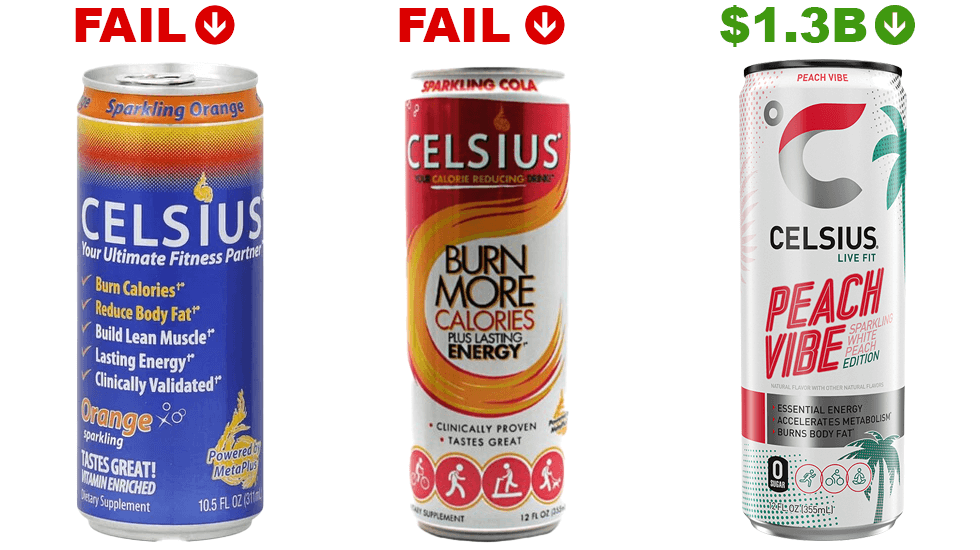The $1.3B Mistake: Celsius’ Initial Branding Strategy
Celsius struggled for years—all because of one CRITICAL MISTAKE:
They were selling the wrong benefit.
When Celsius drink was invented in 2004, it screamed “BURN CALORIES!”
Here’s why that failed:
❌ CONFUSION: Consumers were left wondering, “How does a drink burn calories?”
❌ EMBARRASSMENT: Many people felt uncomfortable carrying around a product that so boldly proclaimed its dieting purpose.
❌ SACRIFICE: The emphasis on calorie-burning left little room to highlight flavor or enjoyment.
In short, Celsius misunderstood its target market. They focused on diet-obsessed consumers instead of people who wanted to enjoy themselves while feeling healthy.
Rebranding for Success: Celsius’ New Approach
Now look at the new can:
✅ ENJOYMENT: Flavor now takes the spotlight, with appealing descriptors like “Sparkling Watermelon” prominently displayed.
✅ PRIDE: A sleek, modern design and the new “Live Fit” tagline position Celsius as a lifestyle brand, not just a diet aid.
✅ HEALTH: While still present, the health benefits are now more refined and less in-your-face.
Celsius’ remarkable turnaround is personified by its CEO, John Fieldly. Joining as CFO in 2012 when the company was struggling, Fieldly became interim CEO in early 2018 and was appointed permanent CEO later that year. Under his leadership, Celsius has grown to capture about 7% of the U.S. energy drink market. Fieldly emphasizes the importance of brand identity, stating, “When you see Celsius and you see our logo and Celsius live fit, it says something more about you than the liquid in the can.” This focus on lifestyle branding, combined with innovative flavor development and strategic partnerships like their distribution deal with Pepsi, has propelled Celsius from a niche product to a major player in the energy drink market.
Celsius’ marketing strategy evolved significantly since its introduction. Initially positioned as a negative calorie drink, the brand struggled to connect with its target market. The turning point came when Celsius rebranded itself as a premium wellness energy drink. This shift in brand identity and advertising approach helps explain how Celsius became so popular in recent years. By focusing on health-conscious consumers and leveraging strategic partnerships, Celsius transformed from a struggling newcomer to a beverage industry success story.
The Conversation Shift:
OLD CELSIUS: “Hey, want to burn calories?”
NEW CELSIUS: “Enjoy this tasty drink!” (Whispers later: “…it’s healthy too.”)
The new approach hooks you with pleasure, then seals the deal with health benefits. This strategy has particularly resonated with Celsius’ revised target market: younger, health-conscious consumers who prioritize both enjoyment and wellness.
This rebrand wasn’t just about packaging—it was about redefining Celsius’ position in the competitive energy drink landscape. As consumers increasingly compare options like Celsius vs. Red Bull or Monster, Celsius has carved out a unique space by emphasizing both enjoyment and health benefits.
Despite its marketing as a healthier alternative, some have questioned whether Celsius is truly good for you, given its high caffeine content. However, this hasn’t slowed its popularity among its target demographic. In the first half of 2023, Celsius reported net revenue of over $700 million, putting it on track to surpass $1 billion in annual revenue for the first time.
Key Takeaways for Marketers and Entrepreneurs
- Don’t ask, “What makes me unique?”
- Instead, ask, “Am I meeting people where they are?”
- That distinction is EVERYTHING in marketing.
The Billion-Dollar Lesson
Celsius’ journey from near-failure to a $1.3 billion success story isn’t just about energy drinks—it’s a masterclass in brand evolution. By pivoting from a niche “calorie-burning” drink to a lifestyle brand that resonates with health-conscious consumers, Celsius has rewritten the rules of the energy drink market.
The lesson? Success isn’t just about having a good product. It’s about understanding your audience, adapting to their needs, and creating a brand that becomes part of their identity. Whether you’re running a startup or managing an established brand, ask yourself: Are you truly meeting your customers where they are?
In today’s fast-paced market, the ability to rebrand and reposition can be the difference between obscurity and billion-dollar success. So, take a page from Celsius’ playbook—don’t be afraid to evolve, to listen to your customers, and to create a brand that’s more than just a product.
Is your brand making the Celsius mistake? The fix could be worth billions. It’s time to energize your approach and transform your brand’s future.
